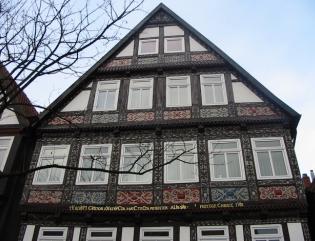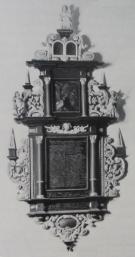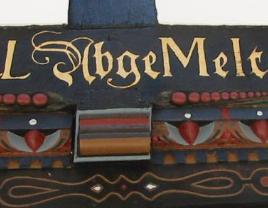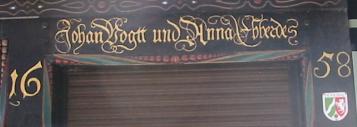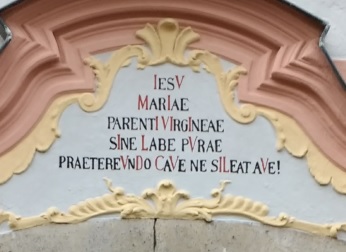What is a Chronogram? top
If the chronogram is a hexameter, you call it a chronostichon.
Chronograms
at Bad Salzuflen top
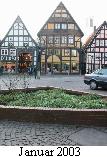 ............. .............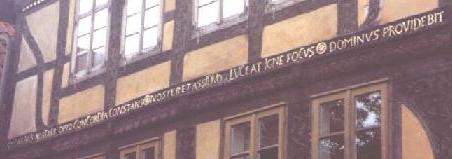 SIT LARIBVS NOSTRIS OPTO CONCORDIA CONSTANS NOSTER ET ASSIDVO LVCEAT IGNE FOCVS There is the addition: DOMINUS PROVIDEBIT (The Lord will manage it.). The sum of the Roman numerals is
The letter T in NOSTRIS is bold while renovated and the author didn't use the letter V in FOCVS in order to get the right year 1621. 2nd Example: In the neighbourhood (Lange Str.1) there is an inscription
The chronogram is psalm 68:2 - slightly altered. Here you get 1625 as the year of building.
3rd Example: Spa Museum top In the spa museum in Bad Salzuflen you can see a joist with two chronograms. In former times it was above the hall entrance of Georg Schröder's house, Loofher's son-in-law. The first line is
The second line is
Both lines contain the year 1630. The first chronogram comes from the Christmas Story St.Luke's Gospel 2:14. It is interesting to know that you can see this biblical saying on the edge of the pulpit roof of St. Kilian's church at Schötmar/Bad Salzuflen. - The second chronogram is a chronodistichon. 4th Example: Salzhof top It is reported that there was a chronostichon on a house (from 1631) at the Salzhof with the wording IOVE SALIS
VIVIT
DOMINVS
LARGITOR
ET AVTOR
There is an anecdote about it:
There are two more half-timbered houses with fragments of chronograms, the "Brandessche Apotheke am Markt" and "Haus Schuseil in der Wenkenstraße". Obviously the chronograms were destroyed and difficult to reconstruct today (8). More Chronograms in the Bad Salzuflen Area top 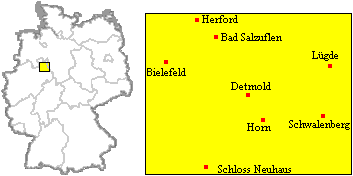 There is a chronogram from 1594 in the "Langen Straße 36" at Detmold.
TV RERVM CVSTOS EXTRVCTA HAEC
TECTA POTENTER ALIS SVB GRATIS PROTEGE
CHRISTE
TVIS
This chronogram is a distichon. The facade of the house
was renovated in 1980. Then they found the chronogram and rich ornaments
at the joist. The chronogram was partly reconstructed.
There is a chronogram at the "Westfälisches Freilichtmuseum Detmold" imported from Kirchhunden-Flape (Kreis Olpe) to Lippe.
EXTRVXERE ADES HANS ET CATARINA
IVGALI
STRICTI VINCLO QVAS DVLCIS REX
SERVET IESVS
At Herford there is a chronogram over a side exit of the catholic church St. Johannes Baptist. 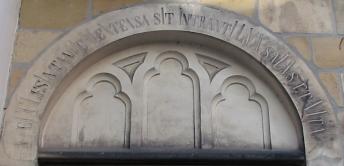
ECCLESIA TANDEM EX TENSA SIT INTRANTI LVX SALVS ET VITA 1890 At Schwalenberg there was a house with a chronodistichon (1656) at the "Pollhof" until the turn of the 18/19th century. It was HAS AEDES NVTV FECERVNT PASTOR ET VXOR HERMANNVS TRINI PAXQVE BONA INSIT IIS (Hermann, the parish priest, and his wife built this house here on the Holy Trinity and peace might live in it [3].) At Horn the house "Mittelstraße 43" has the inscription: NEMO GAVDET VTROQVE SINE CVRA (Nobody enjoys both without trouble[3].) This is wrong. It had to be
The house was renovated in 1975. Only three words of the chronogram were left. The missing letters were added in a wrong way. This is shown in an old photo. - The year 1671 belonged to this chronogram. 
Photo Herbert Penke Herbert Penke from Horn told me that there is a second chronogram. The third gravestone on the web page "alte Grabsteinplatten an der evangelischen Stadtkirche in Horn" has the following chronogram  A chronogram is saved in Lügde (Vordere Straße 41), where the Roman letters were not emphasized. The year is 1798. EX BVSTO AC PHOENIX DOMVS HAC EXSVRGITIN ALTA
A chronogram decorates the baroque portal of the "Meindersschen Hof" in Bielefeld (Obernstraße 40). SOLVS IOVA DOMVS SIT AVTOR ET FAVTOR / VIVENTES IN EO PAX QVE SALVE BEET (God alone is to look after, protect and support this house, peace and prosperity shall be granted to those, who live in it [5].) The year is 1659.
Wiedenbrück is rich in old half timbered houses with some chronograms 1) LAVS HONOR
VIRTVS BENE
DICTIO
ET FORTITVDO SINT
DEO NOBIS PROPITIO
There is a epitaph in Lemgo in the church St.Marien (12./13.century) that reminds on the "lippischen Kanzler" Heinrich Kerkmann (died in 1603). The main plate shows a hymn of praise for him. Six lines are chronogramms.
Chronograms in
German top
1797, W=VV In Lippstadt befindet sich ein schmuckvolles Chronogramm, auch in Deutsch. 1658, W=VV Was wir haben ausgestreut, wird von Gott wohl abgemäht. - Was wir gesät haben, wird von Gott geerntet.
Felix-Bastian Sprung found the following chronogram at the Herrenhaus Wellingsbüttel in Hamburg. 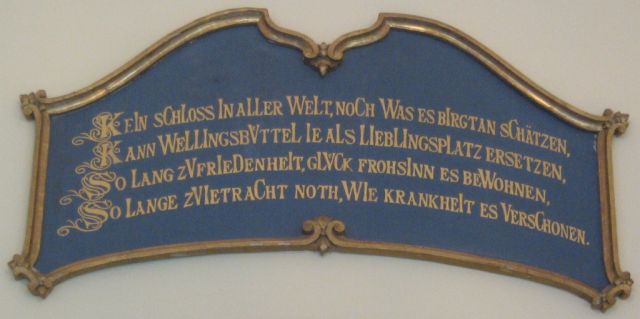
Ü=VE and W=VV leads to the year 1888.
Chronograms
from the Baroque Period top
This chronogram is different. Most of the chronograms on this page come from the (protestant) Northern Germany and are assigned to the Weserrenaissance, which was influenced by the Netherlands. This chronogram belongs to the (catholic) Southern Germany and to the baroque period. This addition is neccessary, so that there is no wrong impression: Chronograms were in great fashion in the baroque period and you find many of them in Southern Germany and the regions of the Austria-Hungarian monarchy. Chronograms from Trieste Guido Ruzzier sent me two chronograms from Trieste. Trieste was one part of the Habsburg Monarchy until 1918. Ich lebe in Frieden mit Gott. (1717) IN IESV CRVCIFIXI HONOREM DENVO RESTAVRATA (This house was) newly restored to honour Jesus Christ Crucified. (1735) Chronograms on the Internet top English Tony Campbell
Wikipedia
Deutsch Webseite des Priesterseminars Brixen
Dr. Hermann Josef Frings
Herbert Penke (nach 8)
Stadt Luxemburg
Wikipedia
Dutch Rik Palmans
Chronogramme aus Westfalen-Lippe und Umgebung Bielefeld
Vellern
Warendorf
I also found references to Chronograms at Büren,
Gemen, Geseke, Jülich, Kloster Dahlheim, Schloss Neuhaus, Soest, Teltge,
Wiedenbrück, and Warburg on the internet.
References top
This page is also available in German. URL of
my Homepage:
© 1999 Jürgen Köller |

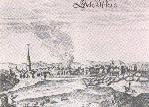 ...
...